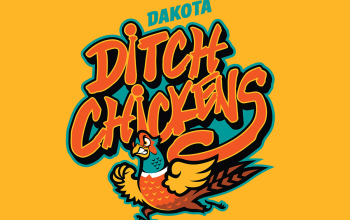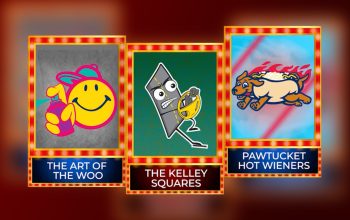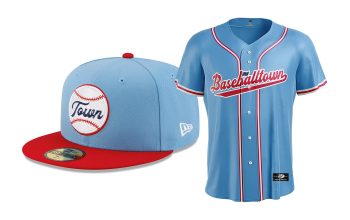If you look at a list of sports teams that play in the city of St. Paul, Minnesota, they seem to have one thing in common: Hockey’s Minnesota Wild, lacrosse’s Minnesota Swarm, and roller derby’s Minnesota RollerGirls all seem a little sheepish about broadcasting exactly where they play. Only the St. Paul Saints of baseball’s independent American Association truly embrace their hometown.
“Everybody else in town is the Minnesota Somethings,” said Tom Whaley, the team’s executive vice president. “It was important to us to be named the St. Paul Saints because that’s the town where we play.”
Of the two Twin Cities, outsiders sometimes overlook St. Paul in favor of Minneapolis. “Say you’re from out of town and you come here, you don’t say, ‘I’m flying to the Twin Cities’ or ‘I’m flying to Saint Paul.’ You say, ‘I’m flying to Minneapolis,’” Whaley said. “St. Paul sometimes gets a little short shrift in that regard.”
But when it comes to baseball, there’s no reason for St. Paul to be sheepish. “Saint Paul is the baseball town—the baseball twin in the town,” Whaley said. “You’ve got Joe Mauer, Dave Winfield, Jack Morris, Paul Molitor, they’re all Saint Paul kids, who grew up on the playgrounds of Saint Paul.”
 The current iteration of the St. Paul Saints was founded in 1993, but the name’s religious origins go back to 1884, when the St. Paul Apostles (pictured above, via Early Teams) played in the city. The first team to go by the name Saints was owned by Charles Comiskey and played in the Western League from 1894 to 1899. That team would move to Chicago’s south side in 1900 and become the American League’s White Sox. Another St. Paul Saints team would play from 1901 to 1960 as a White Sox and Dodgers affiliate in the triple-A American Association.
The current iteration of the St. Paul Saints was founded in 1993, but the name’s religious origins go back to 1884, when the St. Paul Apostles (pictured above, via Early Teams) played in the city. The first team to go by the name Saints was owned by Charles Comiskey and played in the Western League from 1894 to 1899. That team would move to Chicago’s south side in 1900 and become the American League’s White Sox. Another St. Paul Saints team would play from 1901 to 1960 as a White Sox and Dodgers affiliate in the triple-A American Association.
“In the case of our team, it was just kind of a no-brainer to pick that up again,” Whaley said. “We were interested in providing the team with the identity of St. Paul.” (While the Saints’ name doesn’t have much to do with religion, they did once do a Saint Paul bobblehead promotion.)
As for the team’s visual identity, “We’re pretty much meat and potatoes,” Whaley said. “We’ve had two main logos on our shirts in the 22 years, and that won’t change.”
 The first of those logos carries on the timeless tradition of interlocking letter logos in baseball, echoing such classics as the New York Yankees, St. Louis Cardinals, and Los Angeles Dodgers, to name a few.
The first of those logos carries on the timeless tradition of interlocking letter logos in baseball, echoing such classics as the New York Yankees, St. Louis Cardinals, and Los Angeles Dodgers, to name a few.
“We’ll always wear that STP that we wear on the hats. It’s a classic,” Whaley said. “When we talk about branding and marketing and whatever, that’s kind of the one universal, that everyone is like, yeah that ain’t going anywhere.”
The second logo is a traditional script that’s appeared on the team’s jerseys for the duration of the team’s existence.

While the Saints’ visual identity is conservative, they make up for it in other aspects of their operation, beginning with the team’s noteworthy co-owner, Bill Murray, pictured above with onetime Saint Kevin Millar. “He’s a fan and has a genuine interest in the business,” Whaley said. “I would say as owners go, he’s real involved. He’s got a real job, but when it comes to baseball, he’s real active and involved.”
And while Murray doesn’t spend a ton of time in the Saints’ offices, he’s not just involved with the Saints on a lark. “It has to do more with our general approach, our outlook on life and baseball and baseball fans,” Whaley said. “That’s where I think he’s a tone setter.”


That tone has come in to play in the form of some of the team’s promotional events, including the now-infamous Night of Unbelievable Fun—dubbed Atheist Night by the media. On August 10, 2012, the Saints removed the S from their name and became the Mr. Paul Aints, wearing custom jerseys and covering the S in Saints all around their stadium.
The event was sponsored by the Minnesota Atheists, who were holding a conference in town. “The idea for making us the Aints came from the Atheists,” Whaley said. “They thought it would be kind of a fun play on words and we agreed.”
A Night of Unbelievable fun has become an annual tradition in St. Paul, despite a fair amount of blowback from people who find offense in the tradition. “You can do promotions about sex, drugs, and rock ‘n’ roll, but be careful what you wish for if you get religion involved,” Whaley said. (Just to be sure they were okay, the team checked with Charlie Ruud, the team’s all-time winningest pitcher and a Lutheran pastor, and Sister Rosalind, a Roman Catholic nun who gives massages at the ballpark, both of whom gave their blessing to the promotion.)
 The promotion generates even more controversy than the team’s “bobblefoot” giveaway in 2008 did. The team announced bathroom-stall themed promotion shortly after a much-publicized scandal involving US Senator Larry Craig getting arrested for lewd conduct in a restroom in the Minneapolis-St. Paul airport. (“There was an unfortunate incident with a US Senator at the airport in Minneapolis,” Whaley said.)
The promotion generates even more controversy than the team’s “bobblefoot” giveaway in 2008 did. The team announced bathroom-stall themed promotion shortly after a much-publicized scandal involving US Senator Larry Craig getting arrested for lewd conduct in a restroom in the Minneapolis-St. Paul airport. (“There was an unfortunate incident with a US Senator at the airport in Minneapolis,” Whaley said.)
“We caught a lot of flak for that,” Whaley said, “but it was nothing compared to what we got when we did A Night of Unbelievable Fun. We got letters from all over the world on that one.”
The Saints have two traditional logos—no cartoon animal required—that have remained essentially the same since 1993, and they don’t worry too much about marketing to the world outside their hometown. (That said, Bill Murray did wear a Saints cap in Space Jam, which gave the team some publicity.)
However, the Saints’ conservative visual identity belies their willingness to embrace controversy and push the envelope, something independent baseball teams can get away with even more than affiliated minor league teams can. The team’s classic look makes its outrageous promotions that much funnier, like the quiet kid in class who turns out to be a great practical joker. Like their unassuming hometown of St. Paul, home to such cultural contributors as Charles Schulz, F. Scott Fitzgerald, and Mitch Hedberg, there’s a lot more to the Saints than first meets the eye.














